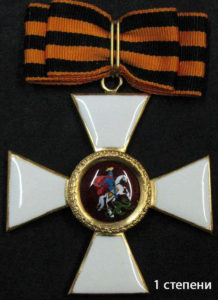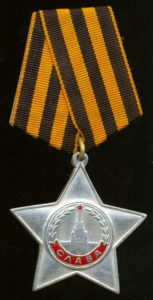 This post is a translation of an article by a Ukrainian politolog and historian in exile Rostislav Ischenko. The translation will be supplemented with commentary, references and images added by yours truly. This is an important reading to understand the symbolism and history of St.George ribbon – “Georgievskaja lentochka” in Russian.
This post is a translation of an article by a Ukrainian politolog and historian in exile Rostislav Ischenko. The translation will be supplemented with commentary, references and images added by yours truly. This is an important reading to understand the symbolism and history of St.George ribbon – “Georgievskaja lentochka” in Russian.
Two years ago Lada Ray published an extensive article on the topic: The Importance of Victory Day, The Immortal Regiment, St. George Ribbon – AND GLOBALIST PLAN FIASCO!, and since then the situation in Ukraine has only gone from bad to worse.
And now, without further ado, the article:
Anton Drobovich against St.George
by Rostislav Ischenko, published 05.05.2020 on the portal Ukraina.ru and at the open blog platform Kont.
On the eve of the Victory Day in Ukraine, as it happened before, there is an increased activity among the nationalists who indict how to “properly” celebrate the holiday. Naturally, leading them all is the Institute of National Memory, the head of which, Anton Drobovich, zealously continues the work of his predecessor Vladimir Vyatrovich to eradicate the memory of the great Victory from the citizens of Ukraine. [Translator note: the naming of the “institute” is the direct nod to Orwell’s “1984”]
Since it is difficult to forbid the grandsons and great-grandsons of the winners to honour the feat of their grandfathers and great-grandfathers, whom most modern Ukrainians still found alive, whose stories they remember, who they are proud of, the powers go after the memories in a round-about ways. To begin with, the Ukrainian government is trying to replace the date and symbol of Victory Day, by moving its celebration to May 8, and by introducing a red poppy instead of the St.George ribbon.
The first one does not catch on. It is mostly the official events that are held in Ukraine on May 8, but the people, including supporters of the Maidan, prefer to celebrate the 9th. But the authorities have almost succeeded with the removal of the St.George ribbon from the festive arrangement. Firstly, it was banned as a “Communist symbol”, and secondly, supporters of the Maidan who go out on May 9 to celebrate the Victory, prefer a poppy as a means of their political identification (so that they, “patriots”, are not confused with “quilted jackets” [translator note: as they call people who are Russian at heart]).
The reason for the postponement of the main state celebrations of Ukraine to May 8 is obvious. The simplest political technology — after a while, the generations who used to celebrate on May 9 will die out, and the new ones, who have been accustomed to the celebrations of the 8th since school, will calmly accept the idea of the “day of remembrance and reconciliation”. They are also taught from childhood that Ukraine was at war with two “totalitarian regimes”, that during the fighting the German occupiers simply replaced the Soviet ones and vice versa, that Ukrainians have nothing to celebrate, and so on. [translator note: another, separate article is coming on this topic later.]
Thirty years later, if Ukraine managed to live for so much longer, the majority would calmly “reconcile” and “honour the memory of UPA soldiers” [translator note: UPA are the Nazi collaborators of WWII]. I am sure that the Soviet soldiers, who are now still remembered after the UPA, will have by then been safely excluded from the festive events. And the few grandparents (today’s thirty-forty-year-olds) going to the Eternal flame on May 9 would be viewed as eccentric marginals. However, by that time they might have extinguished the Eternal flame (to save on scarce gas).
But the question remains, what did St. George, the patron Saint of such worthy allies of Kiev as England and Georgia, do to the Ukrainians, that Kiev fights with the St. George ribbon more fiercely than with red stars and red flags, against which it doesn’t relent either, but still has to admit that the Victory Banner was red, and every year it tolerates re-enactors in Soviet uniforms.

To explain this misunderstanding the especially “advanced” Ukrainian Nazis are consolidating associated, oddly enough, with the twice-hated Russian Communists (for being Communists, and for being Russian). They declare the St. George ribbon is a “Guards” symbol and claim that it is a symbol of the Communist regime, because this attribute is present in large numbers on Soviet awards (the order of Glory, the medal “For the Victory over Germany” and numerous commemorative medals).
 At first glance, it may seem that they are right. After all, the traditional colours of St. George are red and white (usually a red cross on a white field, as on the flags of England and Georgia). However, one must bear in mind that the black and orange ribbon (the colours of smoke and flame) of the Russian Imperial Order of Saint George was introduced by Catherine II. Heraldic colours are present on the badge of the order (a white cross with the image in the centre on a red shield of the figure of Saint George striking a serpent with a spear). The colour of the ribbon was intended to remind that this order is awarded exclusively for military services — heroism shown on the battlefield. (However, since the original colours of the ribbon were approved as black and gold, there is another interpretation — the reproduction of the colours of the state emblem of the Russian Empire. It, however, did not take root, and at the beginning of the XIX century, the colours of the ribbon were interpreted as smoke and flames of battle). In addition, the St. George ribbon was attached to the caps of the sailors of the Guards naval crew, and to the ships awarded with the stern St. George flag.
At first glance, it may seem that they are right. After all, the traditional colours of St. George are red and white (usually a red cross on a white field, as on the flags of England and Georgia). However, one must bear in mind that the black and orange ribbon (the colours of smoke and flame) of the Russian Imperial Order of Saint George was introduced by Catherine II. Heraldic colours are present on the badge of the order (a white cross with the image in the centre on a red shield of the figure of Saint George striking a serpent with a spear). The colour of the ribbon was intended to remind that this order is awarded exclusively for military services — heroism shown on the battlefield. (However, since the original colours of the ribbon were approved as black and gold, there is another interpretation — the reproduction of the colours of the state emblem of the Russian Empire. It, however, did not take root, and at the beginning of the XIX century, the colours of the ribbon were interpreted as smoke and flames of battle). In addition, the St. George ribbon was attached to the caps of the sailors of the Guards naval crew, and to the ships awarded with the stern St. George flag.
This is where the Soviet “Guard’s” ribbon was born. The Navy is an extremely conservative organization. Therefore, when the Soviet Guard was established, the sailors decided to reinstate their pre-revolutionary Guard’s symbols. Obviously, the leadership of the country was ready to look at this through their fingers, but it was impossible in an atheistic state to put the ribbon of the Imperial Order of St. George on the stern flags of the guard ships and on the peakless caps of their sailors. Therefore, the ribbon was approved by two orders of the People’s Commissar of the Navy, Admiral Kuznetsov (on June 10, 1942 and on May 5, 1943). It is in them that the name “Guard’s” is used. The ribbon was then used for the Order of Glory and the medal “For the victory over Germany”, but in these cases it was simply described as a “black and orange ribbon”, and later referred to as the ribbon of the Order of Glory. This (by its order) is the name that was traditional for the ribbons of the Russian (and later Soviet) orders.
 Thus, the St. George ribbon was the only symbol that passed from the Tsarist award system to the Soviet one, and in the latter it was officially called the “Ribbon of the Order of Glory”.
Thus, the St. George ribbon was the only symbol that passed from the Tsarist award system to the Soviet one, and in the latter it was officially called the “Ribbon of the Order of Glory”.
Ukrainian Nazis could say that this is still a “Communist symbol”, but the fact is that their own legislation allows wearing of Soviet orders (despite the fact that they are completely covered with “Communist symbols”), including the Order of Glory. The ban applies specifically to the St. George ribbon, which is not tied to any other symbols.
The Kiev authorities tried to explain this strange selectiveness by the fact that the St. George ribbon has become a symbol of resistance in the South-East and is massively used by the Armed Forces of the DPR/LPR (formerly the Donbass militia). But the fact remains: the Ukrainian Nazis threw themselves at the St. George ribbon long before the February 2014 coup. Yushchenko tried to actively replace it with the symbol of the poppy, even though people were not beaten, jailed or killed for the St. George ribbon back then.
 It is the attitude to the St. George’s ribbon as a symbol of Victory that gives the Ukrainian Nazis away. No matter how much they say that they are fighting the “legacy of the Communist regime” or “Putin’s aggression”, while very much “loving and respecting” the Russian people, in fact they are driven by the deepest Russophobia. The same Russophobia that makes them fight for the demolition of monuments to Pushkin and Catherine II as “symbols of the Communist regime”. (translator note: they the Ukro-Nazis also demolished the monument to General A.V.Suvorov in Odessa and in Kiev, the one who lived between 1729-1800 and lead Russian Cossacks over Alps. According to Ukro-Nazis he was a Communis!)
It is the attitude to the St. George’s ribbon as a symbol of Victory that gives the Ukrainian Nazis away. No matter how much they say that they are fighting the “legacy of the Communist regime” or “Putin’s aggression”, while very much “loving and respecting” the Russian people, in fact they are driven by the deepest Russophobia. The same Russophobia that makes them fight for the demolition of monuments to Pushkin and Catherine II as “symbols of the Communist regime”. (translator note: they the Ukro-Nazis also demolished the monument to General A.V.Suvorov in Odessa and in Kiev, the one who lived between 1729-1800 and lead Russian Cossacks over Alps. According to Ukro-Nazis he was a Communis!)
The very history of the St. George ribbon confirms that it is hated as a symbol of the glory of Russian weapons. This is how it was born in spite of the official (red and white) heraldic colours of St. George. It was in this capacity that it moved to the Soviet award system, replacing – even though under a difffrent name – the ribbon of the Imperial Order of St. George on the peakless caps of the crews of guard ships and on the Order of Glory (according to its Charter, an exact copy of the soldiers’ “Badge of the Order of St. George”, known as the St.George Cross). It is in this capacity — a symbol of all Russian victories, not just the last great Victory — that the Ukrainian Nazis hate it. It is this, the symbol of Russian military glory, that is denounced by those who put the image of a red poppy – or any other “national” symbol of Victory – in their buttonholes.
The USSR was Communist Russia (but still Russia). Modern Russia is the legal successor of both the Soviet Union and the Russian Empire (although not everyone likes it, but neither decades, nor even centuries of the country’s history can be thrown out for ideological reasons). And only where anti-national regimes (hostile primarily to their own people) create an anti-Russia on the breakaway Imperial outskirts (translator note: “outskirt” in Russian is “okraina”), the ribbon in the colours of smoke and flame – which always symbolized the heroism of the Russian soldier – causes animal anger and hatred.
This concludes the translation of the article.
 As a curiosity, here is how a copy the Order of Glory is depicted at a Ukrainian site faleristica.com.ua, so as to avoid persecution by the Ukro-Nazis, with St.George ribbon blurred out:
As a curiosity, here is how a copy the Order of Glory is depicted at a Ukrainian site faleristica.com.ua, so as to avoid persecution by the Ukro-Nazis, with St.George ribbon blurred out:
Ukro-Nazi regime prohibits display of the St.George Ribbon since the 15th of June 2017. First offence is punished by a fine of up to $100 (a significant sum for an impoverished Ukrainian), while second offence is punishable by 15 days in prison. If the person is lucky. If he’s unlucky, Ukro-Nazis would get to him first and maim or murder him. This article from Ukraina.ru from 2018 is telling about a Moldavian citizens, stopped at the border because there was a St.George ribbon in his car. He was arrested, then deported with a 3-year prohibition against entering Ukraine.
For now, this can only be fought with ridicule, just like the boggarts in J.K.Rowling’s famous work. So here come such two ridicules of the Ukro-Nazis. The first is the image that Lada posted in her article 2 years ago:

“Who doesn’t like the St.George Ribbon here?”
…and the second is from a comment to R.Ischenko’s article at Kont, an image that aptly sums up the last two of its paragraphs:


I read your post about your grand-uncle, Georgij Moiseev: “My grand-uncle’s given name – Georgij – is in itself fateful. It is connotative of Victory and courage. It is found in Saint George the Victorious (rus.: Georgji Pobedonosec), and in the St.George Ribbon (rus: Georgievskaja lentochka). The latter is the symbol of courage and self-sacrifice, established by Catherine the Great, and carrying the colours symbolising the fire and smoke of a battle. ”
An admirable heritage, one you should be proud of. Saint George’s Ribbon is a badge of honour.